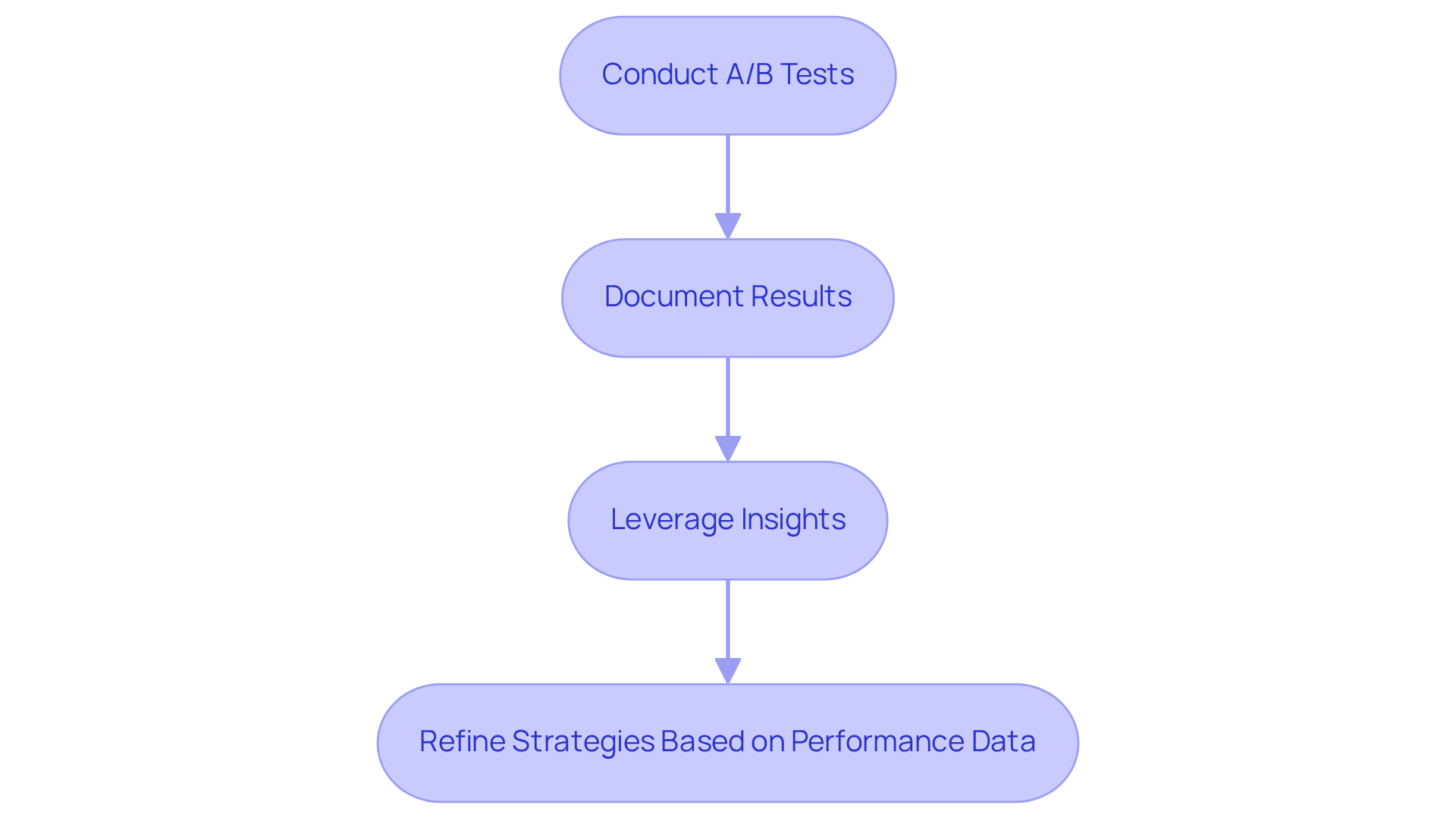
Introduction
In a rapidly evolving digital landscape, the stakes for effective advertising have never been higher. Projections indicate that U.S. video ad spend will soar to nearly $131 billion by 2025. This staggering figure underscores the necessity for companies to refine their strategies and harness the power of advertising statistics.
This article delves into four best practices that empower marketers to leverage data-driven insights, align content with audience preferences, and continuously optimize their campaigns. However, amidst the wealth of information available, how can brands avoid common pitfalls and truly maximize their ad impact?
Leverage Advertising Statistics to Inform Strategy
To maximize the impact of their ads with statistics, companies must prioritize the analysis of key advertising statistics. In 2025, overall video ad spend is projected to reach $130.97 billion in the U.S. This figure underscores the necessity for a creative strategy that emphasizes video content, as video ads are expected to significantly outperform other formats. Furthermore, social media advertisements are projected to represent nearly 40% of overall digital advertising expenditure, with U.S. social commerce sales predicted to surpass $85 billion. This highlights the need for companies to dedicate substantial resources to these platforms.
Tools such as HubSpot and Statista can provide valuable insights into audience engagement and ad performance metrics. Notably, U.S. advertisers are expected to spend $60.94 billion on mobile social media video ads in 2025. By leveraging these statistics, companies can create ads with statistics that enable informed decisions, significantly enhancing their advertising effectiveness and return on investment. As Todd Kaplan, CMO of Kraft Heinz, suggests, marketers should approach product development thoughtfully, akin to pointillism, ensuring that every decision is strategic and data-driven.

Align Ad Content with Audience Insights
To create effective ads with statistics, companies must align their content with consumer insights derived from comprehensive research. Understanding demographics, interests, and pain points is essential. For instance, if research reveals that a significant portion of the target demographic prefers comedic material, it’s clear that humor should be woven into marketing strategies.
Research indicates that ads with statistics, especially those that are humorous, can significantly enhance viewer engagement, leading to improved recall and conversion rates. Specifically, a 10% increase in average focus across mediums correlates with a 17% increase in spending, underscoring the financial benefits of engaging content and ads with statistics. Tools like Facebook Audience Insights offer valuable information on consumer preferences, enabling companies to tailor their messaging effectively.
Furthermore, successful campaigns, such as those highlighted in the 'Impact of Consumer Focus on Spending' case study, demonstrate how leveraging consumer insights can yield improved marketing outcomes. By ensuring that promotional content resonates with the interests and needs of viewers, companies can create ads with statistics that not only boost engagement but also drive higher conversion rates, ultimately maximizing their marketing impact.
However, companies must be cautious of common pitfalls in audience research, such as overgeneralizing data or neglecting to test various messaging approaches. These missteps can hinder advertising effectiveness. Are you ready to refine your advertising strategies and connect more deeply with your audience?

Utilize Performance Metrics for Continuous Optimization
Brands must establish a robust system for tracking performance metrics to ensure continuous optimization of their ads with statistics. Key metrics to monitor include:
- Click-through rates (CTR)
- Conversion rates
- Return on ad spend (ROAS)
For example, a low CTR in a specific ad set may signal that adjustments in creative or targeting are necessary. By consistently analyzing these metrics, companies can identify trends and make data-informed decisions that enhance the performance of ads with statistics.
Furthermore, utilizing analytics tools such as Google Analytics or Adverity can streamline this process. These tools provide real-time insights through ads with statistics that inform optimization strategies, allowing brands to stay ahead of the competition. Are you ready to take your ad campaigns to the next level? Engage with these analytics solutions to unlock their full potential.

Implement Testing and Iteration for Ad Effectiveness
To maximize ad effectiveness, companies must embrace a culture of testing and iteration. This means conducting A/B tests on various elements of ad campaigns - think visuals, copy, and calls-to-action. For instance, testing two different headlines can uncover which one resonates more with the audience, ultimately leading to improved engagement.
It's crucial to document the results of these tests and leverage the insights gained from ads with statistics to inform future campaigns. By continuously refining ads with statistics based on performance data, brands can sharpen their strategies and achieve better results over time.

Conclusion
Maximizing ad impact is not just a goal; it’s a necessity in today’s competitive landscape. The strategic use of statistics is crucial for informing and enhancing marketing efforts. By integrating data-driven insights into advertising strategies, companies can craft campaigns that truly resonate with their target audiences, driving better engagement and conversion rates.
Key practices are essential for success:
- Aligning ad content with audience insights
- Utilizing performance metrics for ongoing optimization
- Fostering a culture of testing and iteration
Companies must leverage tools and analytics to continually refine their approaches. Understanding consumer preferences and behaviors is paramount, as it directly influences the effectiveness of advertising strategies.
As the advertising landscape evolves, brands must remain agile and data-focused. Embracing these best practices not only enhances the effectiveness of ad campaigns but also fosters deeper connections with audiences. What steps will your company take to refine its advertising strategies? Now is the time to ensure that your approach is informed by statistics and responsive to the ever-changing market dynamics.
Frequently Asked Questions
What is the projected video ad spend in the U.S. for 2025?
The projected video ad spend in the U.S. for 2025 is $130.97 billion.
Why is video content important for advertising strategies?
Video ads are expected to significantly outperform other formats, making it essential for companies to emphasize video content in their advertising strategies.
What percentage of overall digital advertising expenditure is projected to come from social media advertisements?
Social media advertisements are projected to represent nearly 40% of overall digital advertising expenditure.
What are the predicted U.S. social commerce sales for 2025?
U.S. social commerce sales are predicted to surpass $85 billion in 2025.
Which tools can help companies analyze advertising statistics?
Tools such as HubSpot and Statista can provide valuable insights into audience engagement and ad performance metrics.
How much are U.S. advertisers expected to spend on mobile social media video ads in 2025?
U.S. advertisers are expected to spend $60.94 billion on mobile social media video ads in 2025.
How can companies leverage advertising statistics to improve their strategies?
By leveraging advertising statistics, companies can create data-driven ads that enable informed decisions, significantly enhancing their advertising effectiveness and return on investment.





